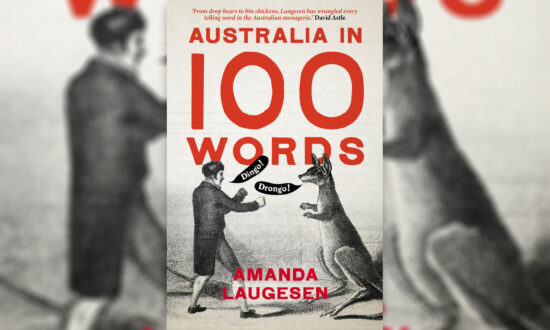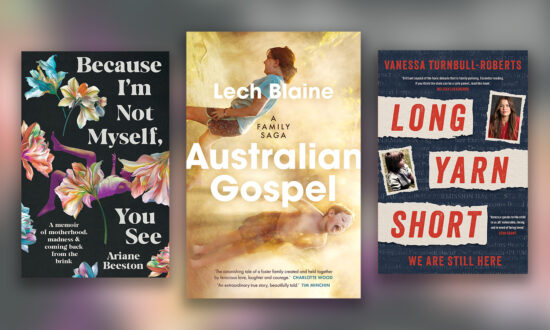“In the future, everyone will be world-famous for fifteen minutes,” read the yolk-yellow wall, as my husband and I entered the Art Gallery of South Australia’s Andy Warhol exhibition last weekend.
As we wandered, I admired the way the work sprang so energetically, sometimes elegantly, often louchely, from the lives of the artists.
 Alongside the famous pop art icons – the silkscreens of Elvis and Marilyn, the Campbell’s soup cans – was documentary art, born of observing and capturing everyday life for the kind of people who expect to be looked at. Bianca Jagger in her spaghetti straps, shaving her armpits for a night out, telephone receiver in the lap of her evening gown. Liza Minnelli in full make-up and a dressing gown. Christopher Reeve, almost clumsily handsome, making Warhol’s apartment couch seem like doll furniture beneath his big farmhand frame as he was interviewed for Warhol’s Interview magazine. Keith Richards biting unidentified flesh. Dustin Hoffman cycling through New York, with his young daughter and her babysitter.
Alongside the famous pop art icons – the silkscreens of Elvis and Marilyn, the Campbell’s soup cans – was documentary art, born of observing and capturing everyday life for the kind of people who expect to be looked at. Bianca Jagger in her spaghetti straps, shaving her armpits for a night out, telephone receiver in the lap of her evening gown. Liza Minnelli in full make-up and a dressing gown. Christopher Reeve, almost clumsily handsome, making Warhol’s apartment couch seem like doll furniture beneath his big farmhand frame as he was interviewed for Warhol’s Interview magazine. Keith Richards biting unidentified flesh. Dustin Hoffman cycling through New York, with his young daughter and her babysitter.
That lived art – and art as a way of life – made me think of Libby Angel’s work of autofiction, set in ’90s Melbourne, Where I Slept (Text Publishing). The narrator, a mostly unemployed sometimes artist, starts the novel living in a cracking, rotting boarding house in a regional town, after being “spat out” from university. The landlord’s office is full of mannequins; her neighbours include a sex worker and her boyfriend, who have a gun in their room.
She soon flees to take up a former university friend’s offer of a place to stay. “In between studying Russian constructivism and Yoko Ono we had been comparing fathers: whose was worse, more faithless, abusive and alcoholic. In the end, it was neck and neck.” It’s one of the few fleeting mentions of family in the book, and the first of many moves.
The narrator is alternately spiky and selfish, and authentically good: sometimes both at once. Staying in a friend’s share-house room while she’s overseas, she starts an affair with a housemate who has a girlfriend, and one day convinces the girl to shave her head, knowing her boyfriend will hate it. Not because she particularly wants him, but because she can. She impulsively invites a homeless woman to accompany her home, where she gifts her a generous array of op-shop clothes she no longer needs and lets her stay while she sleeps, because it’s raining. She buys a saxophone from a pawn shop, teaches herself to imperfectly play and joins bands of varying abilities. She makes street art. She performs dances, sometimes terribly. “I hope you weren’t paid for that,” says a friend of a friend, after a gig. “Because that was really shit.” She and her housemates make a “silent horror-porn” film, involving pretending to fantasise about Iggy Pop.
The book, like the art of Warhol and his contemporaries, is presented in jagged, crafted sections. It feels carved from life (and it’s labelled autofiction, so I imagine it is). It depicts a life of amateur art-making, on the edges of “normal” life, amid a shifting community of outsiders. It has a seedy, sometimes ugly, glamour.
In a sense, Where I Slept is a ’90s version of Helen Garner’s Monkey Grip, with its inner-Melbourne network of share houses, artists and addicts, all bicycling between pubs and homes. But it’s something far stranger and darker: where Garner’s narrators take practical pleasure in folding sheets over a clothesline or cooking wholesome dinners, this narrator has “an inability to walk the clown-walk of adulthood” and declares herself “no good with the thingness of things”. Garner’s narrators are finding a new normal; Angel’s narrator rejects normal altogether. Perhaps she’s been rejected by it.
 Artists are the focus of Claire Dederer’s fascinating Monsters: A Fan’s Dilemma (Sceptre). “I wasn’t supposed to love this work, or this man,” she reflects on its first page, referring to Roman Polanski. He, of course, made some of the greatest films of the last century – Chinatown, Rosemary’s Baby – and drugged and anally raped 13-year-old Samantha Geimer, at Jack Nicholson’s house, during a commissioned Vogue shoot.
Artists are the focus of Claire Dederer’s fascinating Monsters: A Fan’s Dilemma (Sceptre). “I wasn’t supposed to love this work, or this man,” she reflects on its first page, referring to Roman Polanski. He, of course, made some of the greatest films of the last century – Chinatown, Rosemary’s Baby – and drugged and anally raped 13-year-old Samantha Geimer, at Jack Nicholson’s house, during a commissioned Vogue shoot.
“I’d spent my life being disappointed by beloved male artists,” Dederer continues. Her list includes Woody Allen, John Lennon (who beat his first wife), Lou Reed (abuse, racism, anti-Semitism). They’re on my list, too.
As a teenager, I was a huge John Lennon fan: his poster looked down on my lavender-quilted childhood bed. I remember recoiling from a famous biography that detailed his heroin use and worse deeds, deciding not to read it because my mind wouldn’t let it be true. I tried again a few years ago, after picking up a fly-spotted copy of the book from a record fair in Semaphore. I believed it this time, but was again repulsed. I still listen to his records. There is an Abbey Road framed picture in our lounge room.
Monsters asks: What do we do with the art of monstrous men? (They’re usually men.) The women – Doris Lessing, Joni Mitchell – are mostly monstrous for abandoning or ignoring their children; the men are mostly monstrous for violence or sexual misconduct. It’s cleverly illustrated in this reflection: “I lie awake worrying about [childcare], and meanwhile old Pablo [Picasso] was putting out cigarettes on his girlfriend’s face.”
Dederer decides a better term than the othering, distancing, absolute “monster” is “the stain”. It describes the way a work we love is irrevocably affected by our knowledge of the maker’s crimes. “We don’t decide that coloration will happen… It’s already too late. It touches everything.” What we do with the stain, she writes, is up to us. There’s not a wrong or a right way to react. It’s about our individual relationship to the art. And what’s more, our decision about whether or not to consume the art won’t change anything.
She acknowledges the importance of feelings – both in making decisions about how to deal with art monsters and as a response to art
In our capitalist, consumer culture, what we like has come to define us. As Nick Hornby wrote in High Fidelity: “What really matters is what you like, not what you are like… Books, records, films – these things matter.” The novel’s record-store-snob narrator eventually realises (sort of) that these things actually matter less than he’d assumed. That love might mean letting people like what they like, instead of trying to “educate” them to like the “correct” things. The mixtape Rob compiles to close the book, of songs his girlfriend actually likes, acknowledges the validity of her own taste, and personhood. But in doing that, it still defines personhood by taste.
And that self-definition, argues Dederer, is why “the stain” matters so much. It’s why the Harry Potter wars are so fierce. JK Rowling’s books seemed to offer readers, especially those who felt they didn’t belong, “a navigable system of belonging”, with their sorting hats. But when she began to make public judgments about trans people, she signalled to many passionate fans that her “tale of a place where otherness was accepted didn’t include them”. Their childhoods were stained.
This is just one of many fascinating byways the book explores. I love that it’s not simple. That Dederer doesn’t claim to have answers, or offer rules. That she acknowledges the importance of feelings – both in making decisions about how to deal with art monsters and as a response to art. Objectivity, she argues, is not just impossible, but a product of the ubiquitous subjectivity of the white male critic, which masquerades as universal authority.
“What if criticism involves trusting our feelings – not just about the crime, which we deplore, but about the work we love.”
Sometimes that does mean rejecting the work. Dederer writes, like many women I know (including me), that she can no longer watch Woody Allen’s Manhattan, which centres on 42-year-old Allen’s love affair with a literal high-schooler, played by 17-year-old Mariel Hemingway (granddaughter of art monster Ernest Hemingway, incidentally). The “stain” of Allen’s relationship with Soon-Yi, most generously interpreted as his long-term partner’s daughter, is too overwhelming.
 I grew up loving another work I’m now ashamed to admit to: Gone with the Wind. First and foremost, it was the film, shown over two nights on television, starring the glamorous Vivien Leigh as Southern belle (and plantation daughter) Scarlett O’Hara and Clark Gable as dashing rogue Rhett Butler. But I did once, thinking myself very grown-up, borrow Margaret Mitchell’s book from the library and read it. My memory has been entirely overtaken by the screen version. Of course, I now realise it’s a romance not just in the sense of Scarlett’s army of admirers and the Rhett-Ashley love triangle, but a “romance” of the slavery-era South that ignores, glosses over and straight-up lies about its realities.
I grew up loving another work I’m now ashamed to admit to: Gone with the Wind. First and foremost, it was the film, shown over two nights on television, starring the glamorous Vivien Leigh as Southern belle (and plantation daughter) Scarlett O’Hara and Clark Gable as dashing rogue Rhett Butler. But I did once, thinking myself very grown-up, borrow Margaret Mitchell’s book from the library and read it. My memory has been entirely overtaken by the screen version. Of course, I now realise it’s a romance not just in the sense of Scarlett’s army of admirers and the Rhett-Ashley love triangle, but a “romance” of the slavery-era South that ignores, glosses over and straight-up lies about its realities.
I was shocked, however, by some of the revelations by Sarah Churchwell, author of The Wrath to Come: Gone With the Wind and the Lies America Tells (Head of Zeus). Did you know Ashley Wilkes, the effete blond Southern gentleman Scarlett is infatuated with, was written as a leader of the Ku Klux Klan? The film blurs this fact, not mentioning the Klan by name, but the book makes it explicit. And why was Rhett Butler in jail, when Scarlett visits him sumptuously dressed in a green velvet gown made from curtains (the second-best curtain outfit in film history, after the Von Trapp children’s play clothes)? In the film, he obfuscates, saying the Yankees trumped up a charge. In the book, he’s explicitly imprisoned for killing “this darky who had insulted a white woman”. Later, he tells Scarlett, admitting his guilt: “What else could a Southern gentleman do?”
The film of Gone with the Wind, produced by the Jewish David O Selznick, was released in the same month World War II erupted in Europe: September 1939. Four years earlier, Hitler’s Nuremberg race laws, explicitly modelled on American race laws, were enacted in Germany. Churchwell’s book traces a through line of American racism, from slavery to the civil war and its aftermath, to Gone with the Wind’s publication 75 years later, to the present-day: the killing of George Floyd and the storming of the Capitol, where some carried Confederate flags.
“From the beginning of Donald Trump’s campaign to the turbulent end of his presidency, debates raged about whether his supporters were motivated by economic anxiety or racial animus. But in America the two are intertwined in a system of racial capitalism. Gone with the Wind doesn’t just romanticize that system – it eroticizes it,” Churchwell writes. Despite all this, her feeling is that we shouldn’t bury Gone with the Wind, but revisit it and think about its impact, in order to better understand – and reform – contemporary America.
Fifteen minutes of fame may have seemed like a lot in 1968, when Warhol was famously quoted (some say misquoted). But 55 years later, in our age of social media – with which the Art Gallery’s recent Warhol exhibition was obliquely in conversation – it seems paltry.
 Adelaide author Allayne Webster’s latest novel for young adults, Selfie (Text Publishing), engages with the very 2020s question of being looked at, through the protagonist’s infatuation with a new classmate: a famous influencer. Dene is 13, and has been “Insta famous” since she was a baby. Her mother bugs her to do her sponsored posts like my mum once bugged me to do my homework.
Adelaide author Allayne Webster’s latest novel for young adults, Selfie (Text Publishing), engages with the very 2020s question of being looked at, through the protagonist’s infatuation with a new classmate: a famous influencer. Dene is 13, and has been “Insta famous” since she was a baby. Her mother bugs her to do her sponsored posts like my mum once bugged me to do my homework.
“How could Dene possibly feel bad with all these people saying nice stuff to her?” marvels Tully, whose artist mum has left and whose business-success dad spends most of his time interstate, leaving her and her brother with their practical, nurturing stepmother, Michelle. “When you’re so focused on someone else, you can lose sight of who you are,” Michelle gently warns Tully, of her obsession with the glamorous Dene (at the expense of her long-time friendship with Kira, a fellow burgeoning artist). But Tully, who is pushing down her bad feelings about her parents’ absence, is addicted to the distracting dopamine rush of Dene, whose attention feels validating. “Dene was all I needed.”
Of course, Dene has her own problems: performing a purchased version of yourself that supports your family is not actually that rewarding. And when you’re loved for who you appear to be, it’s hard to recognise what’s real.
Allayne Webster is a charismatic, kinetic writer whose novels crackle with intelligence, humour and warmth. (Here’s where I insert a disclaimer: I published Allayne’s previous novel, in a previous job – because I love her writing.) She’s expert at smuggling moral messages into vibrant, funny narratives that speak authentically to teen readers. Here, they are: be your authentic self, do what you love because you love it, be careful about hunting for validation, face your problems instead of hiding from them with self-soothing behaviour.

Get InReview in your inbox – free each Saturday. Local arts and culture – covered.
Thanks for signing up to the InReview newsletter.
I loved this novel, and would recommend it for readers of any age. And I think I even learned from it. Tully’s path back to herself, after events take a dive, comes through immersing herself in her art for the pure love of it. Instead of performing or grooming herself for Instagram, she shares the work she creates there. And then – even better – she manages to teach herself not to count her likes, but to see Instagram as an album of sorts: a record of what she’s made. It’s not about being looked at, but being herself. Whether anyone’s looking or not.
Jo Case is a monthly columnist for InReview and deputy editor, books & ideas, at The Conversation. She is an occasional bookseller at Imprints on Hindley Street and former associate publisher of Wakefield Press.
Support local arts journalism
Your support will help us continue the important work of InReview in publishing free professional journalism that celebrates, interrogates and amplifies arts and culture in South Australia.
Donate Here




